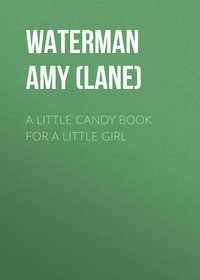 полная версия
полная версияA Little Preserving Book for a Little Girl
Placing the saucepan over the fire, she let the currants heat through gradually, stirring occasionally with a wooden spoon, and when thoroughly scalded she lifted out the currants with a skimmer.
Adelaide boiled the juice until it thickened, then added the currants again and let them just boil up. They were then ready to put into the sterilized pint jar, so Adelaide filled it to overflowing. Next she inserted a silver knife between the jar and the fruit, to let all air bubbles rise to the top and break, placed a new rubber on the jar smoothly, sealed quickly and stood upside down out of the way of any draft.
In the morning the jar was examined carefully to be sure it did not leak, all stickiness was wiped off with a damp cloth from the outside, then the label was pasted on and Adelaide stored the jar away in the preserve closet.
Spiced Cherries
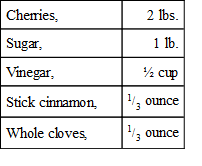
Adelaide stemmed the cherries and washed them in the colander by dipping it up and down several times in a pan of clear cold water, after which she stoned them. Into a saucepan she measured one-half a cup of vinegar. To this she added a third of an ounce each of whole cloves and cinnamon tied up in a muslin bag. The vinegar and spices Adelaide let boil gently for fifteen minutes, then she added one pound of sugar and boiled the mixture ten minutes longer, stirring constantly with the wooden spoon and skimming well. At the end of the ten minutes Adelaide dropped in the cherries and cooked the fruit gently for one-half hour. Lifting out the cherries with a skimmer, she put them into the sterilized pint jar, added the juice to overflowing, and inserted a silver knife between the jar and the fruit to let all air bubbles rise to the top and break. Then she placed on a new rubber and sealed quickly, standing the jar upside down out of the way of any draft.
The next morning, after carefully inspecting the jar for any possible leaks, Adelaide wiped off all stickiness from the outside with a damp cloth, pasted on the label and stored the jar away in the preserve closet.
Spiced Gooseberries
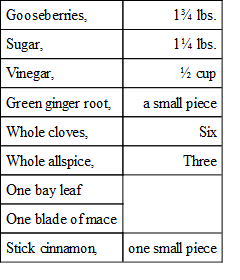
From the gooseberries Adelaide removed the tops, then washed them in the colander, which she placed in a pan of clear cold water and dipped up and down several times. While these drained, Adelaide measured the half cup of vinegar and one and one-fourth pounds of sugar into the saucepan. Placing the saucepan on the fire she brought the sugar and vinegar to the boiling point, added the gooseberries, then removed the saucepan from the fire.
The small piece of green ginger root she cut into small pieces, the six whole cloves, the three whole allspice, the bay leaf, the blade of mace, and the piece of stick cinnamon were tied in a small piece of muslin and added to the contents of the saucepan. Covering the saucepan, it was placed aside over night.
The next day Adelaide brought the fruit quickly to the boiling point and cooked the gooseberries gently until they were tender but not broken. When they were done, she carefully skimmed out the gooseberries and placed them into the sterilized pint jar, then filled it to overflowing with the syrup. Between the jar and the fruit Adelaide inserted a silver knife, to allow all air bubbles to rise to the top and break. The new rubber was placed on smoothly, and she sealed the jar quickly, standing it upside down out of the way of any draft.
In the morning the jar was carefully wiped with a damp cloth to remove all stickiness and examined for any possible leaks. Next Adelaide pasted on the label and stored the spiced gooseberries away in the preserve closet.
Spiced Pears
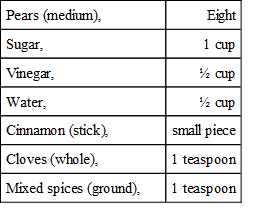
Mother said she found that when she put up "spiced pears" the year before that it took fifteen pears of medium size to fill a quart jar, so she told Adelaide to prepare eight pears. Adelaide washed, wiped, pared, quartered and removed the core from each pear.
The cup of sugar, half cup each of water and vinegar, cinnamon stick and whole cloves were put into the saucepan and placed over the fire, then the teaspoon of mixed ground spices was also added; the latter were tied in a small piece of muslin.
These Adelaide let boil for five minutes, after which she skimmed the syrup and added the pears. It was necessary to boil the pears very gently for thirty-five minutes, stirring them frequently with the wooden spoon, but carefully so as not to break the fruit. When they were done Adelaide lifted the pears out carefully with a silver fork into the sterilized pint jar, and poured in the syrup to overflowing.
With a silver knife, which she inserted between the fruit and jar, she let all air bubbles rise to the top and break, then fitted on a new rubber smoothly, sealed the jar quickly and stood it upside down out of the way of any draft. In the morning, after examining the jar carefully to see that it did not leak, Adelaide wiped off all stickiness with a damp cloth, pasted on the label and stored the jar away in the preserve closet.
Spiced Peaches
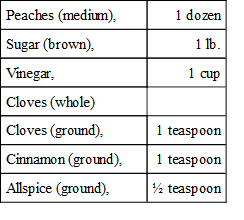
Adelaide put the pound of brown sugar and the cup of vinegar into the saucepan and added the ground spices (clove, cinnamon, and allspice) tied up in a small piece of muslin. The saucepan she placed over the fire and let the contents boil gently for ten minutes.
While the syrup was boiling, Adelaide poured boiling water over the peaches, and after they had stood a minute she peeled them with a silver knife. Adelaide left the peaches whole, and stuck four or five cloves in each peach.
As soon as the syrup had cooked sufficiently she dropped the peaches in it and cooked them until they could be pierced easily with a silver fork.
The twelve peaches were enough to fill two pint jars. Adelaide lifted the peaches out carefully with the silver fork and placed them in the sterilized jars. Then she filled the jars to overflowing with the syrup. With a silver knife, which she inserted between the fruit and the jar, Adelaide let all air bubbles rise to the top and break. Next, new rubbers were fitted on smoothly and the jars sealed quickly, after which she stood them upside down out of the way of any draft. In the morning the stickiness was wiped from each jar with a damp cloth, they were carefully inspected to be sure there were no leaks, then Adelaide pasted on the labels and stored the jars away in the preserve closet.
Spiced Watermelon Rind
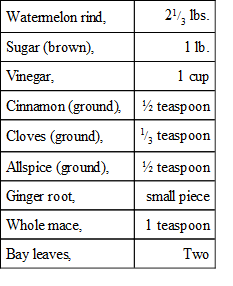
One day when watermelons were in their prime Adelaide's mother bought a part of one for dessert. She told Adelaide to save all the rind and the next day she would show her how to make another tasty relish to be eaten with cold meats.
In the morning Adelaide pared the rind neatly and cut it into many attractive shapes. The saucepan had been previously placed over the fire, containing the pound of sugar, the cup of vinegar, the piece of ginger root, the whole mace and the bay leaves. The ground spices, one-half teaspoon each of cinnamon and allspice, and the one-third teaspoon of cloves, were tied in a small piece of muslin and added to the syrup. When the syrup reached the boiling point Adelaide dropped in the watermelon rind, and it was cooked slowly until perfectly tender. Then Adelaide lifted out the rind very carefully with a silver fork into a dish, covered, and stood it away over night. The saucepan was removed from the fire and placed aside to cool. Next morning, Adelaide let the syrup again come to the boiling point, and added the rind. She watched carefully, and when it came to the boiling point a second time she lifted the rind carefully with a silver fork into the sterilized jar. The syrup she poured in until it overflowed.
Inserting a silver knife between the jar and the rind Adelaide let all air bubbles rise to the top and break, then fitted the new rubber on smoothly, sealed quickly and stood the jar upside down out of the way of any draft.
In the morning Adelaide wiped off all stickiness from the outside of the jar, examined it carefully to be sure it did not leak, pasted on the label and stored it away in the preserve closet.
Spiced Grapes
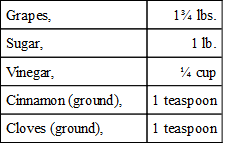
Adelaide picked over and washed the grapes by placing them in the colander and dipping it up and down several times in a pan of clear cold water. After draining thoroughly she removed the skins and placed them in a dish which she stood aside. The pulps were put into the saucepan and cooked slowly until the seeds could be removed by pressing the grapes through a strainer.
The strained pulp, the skins, the pound of sugar, the fourth of a cup of vinegar, and the teaspoon each of ground cinnamon and cloves (the spices were tied in a piece of muslin) were all put in the saucepan together and cooked until thick. Adelaide then filled the sterilized jar with the fruit, inserted a silver knife between the grapes and the jar to let the air bubbles rise to the top and break, fitted on a new rubber smoothly, sealed the jar quickly and stood it upside down out of the way of any draft. In the morning she inspected the jar carefully to be sure that it did not leak, wiped off all stickiness with a damp cloth, pasted on the label and stored the jar away in the preserve closet.
Spiced Blackberries
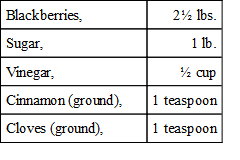
Adelaide put the pound of sugar, the half cup of vinegar, and the teaspoon each of ground cinnamon and cloves (the spices she tied in a piece of muslin) into the saucepan over the fire.
While the syrup was coming slowly to the boiling point Adelaide picked over and washed the blackberries by placing them in the colander, which she dipped up and down several times in a pan of clear cold water. After the blackberries had drained well and the syrup had come to the boiling point Adelaide added the blackberries. These she let boil gently for fifteen minutes, when she skimmed out the blackberries and dropped them carefully into the sterilized pint jar. Next she filled the jar to overflowing with the syrup, inserted a silver knife between the fruit and the jar to let all air bubbles rise to the top and break, fitted on a new rubber smoothly, sealed the jar quickly, and stood it upside down out of the way of any draft.
In the morning Adelaide inspected the jar carefully to see that it did not leak, wiped off all stickiness from the outside with a damp cloth, pasted on the label and stored the jar away in the preserve closet.
"Perhaps," said mother, "you may like to try other fruits another year, preserved in vinegar and sugar with spices, but I think for the present the ones I have given you will do."
"Yes, I think so too," replied Adelaide.
CHAPTER VII
PICKLES
Adelaide had never been allowed to eat many pickles, because mother did not approve of them for growing children, but an occasional sample had made Adelaide look forward to the time when she could have the same privilege as "grown ups," to eat anything she liked. The thought of preparing the pickles seemed to Adelaide the next best thing to eating them.
"I hope when I put up 'pickled onions' I don't cry," laughed Adelaide. "I can just remember grandma peeling a great big pan of onions and the tears rolling down her cheeks."
"Well, Adelaide," said mother, "if you will peel your onions under running water you won't need to waste any of your tears over them."
Mother said she would start Adelaide with the small pickled beets, as they were not only a general favorite, but exceedingly attractive to look at.
The vinegar used was the very best cider vinegar, as it did not pay to use any other kind.
Pickled Beets
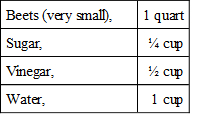
Mother ordered her beets from a market gardener and he brought them to her fresh. Mother always asked for the very, very small ones.
Adelaide cooked the beets until she could pierce them easily with a silver fork, plunged them into cold water, peeled and filled two sterilized pint jars. The half cup of vinegar, the fourth cup of sugar, and the cup of water, were put in a saucepan. Adelaide placed it over the fire and let it come to the boiling point.
After boiling the mixture for two minutes, Adelaide filled the jars to overflowing with the syrup. Inserting a silver knife between the beets and the jar she let all air bubbles rise to the top and break. To fit on a new rubber smoothly, seal the jar quickly and stand it upside down out of the way of any draft, was the work of but a moment.
The next morning Adelaide wiped the outside of the jar with a damp cloth, examined it carefully to see that it did not leak, pasted on the label and stored the jar in the preserve closet.
Pickled Onions No. 1
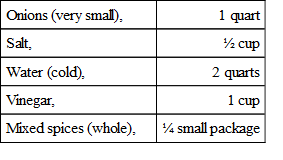
This recipe was one that had been given to Adelaide's mother by a dear old friend. The onions were just the common variety but very small, not much larger than a good sized cherry.
Adelaide poured boiling water on the onions, as it made them easier to peel, then she let the cold water run into the pan all the time she was peeling them. This was to prevent her wasting precious tears. The little sharp knife was the best one to use.
A quart of onions does not sound very big, but before Adelaide finished peeling them she thought she would never come to the end, there seemed so many.
Into a large saucepan she measured two quarts of cold water and one-half a cup of salt, then added the onions.
These stood for twenty-four hours, covered, after which she poured off the brine (mother explained to Adelaide that that was what they called the salt and water) and rinsed them by pouring clear cold water on them.
After draining the onions well in the colander, she filled two sterilized pint jars with the onions.
The cup of vinegar and fourth of a package of whole mixed spices (the package was the size that sold for ten cents before the war) were put in a saucepan and simmered slowly on the fire for one hour, after which Adelaide divided the vinegar and spices equally between the two jars and filled them to overflowing with cold vinegar.
She inserted a silver knife between the onions and the jars to let the air bubbles rise and break, fitted on a new rubber smoothly, sealed quickly and stood the jars upside down over night.
In the morning she wiped the jars thoroughly with a damp cloth, inspected them carefully to be sure that they did not leak, pasted on the labels and stored the jars away in the preserve closet.
Mother said these would need to stand a month before they would be ready to be eaten.
Pickled Onions No. 2
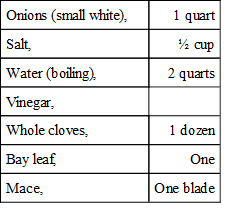
The onions used in this recipe were what are called the "silver skins" or little white button onions.
After Adelaide poured boiling water on the onions, so that she could peel them more easily, she let the cold water run in the pan and peeled the onions (with the little sharp knife) under running water to prevent the tears from falling.
The onions she placed in a stone jar and poured over a brine made of two quarts of boiling water and one-half of a cup of salt.
These she covered and let stand over night.
The next morning Adelaide emptied the onions into the colander, draining off the brine and rinsing them in clear cold water.
Into a saucepan she poured enough vinegar to cover the onions, added the dozen whole cloves, the blade of mace and the bay leaf and let them come slowly to the boiling point. Then she added the onions and moved the saucepan towards the back of the range to let it stand for fifteen minutes.
At the end of that time Adelaide filled the two sterilized pint jars with the onions, poured over the hot vinegar and spices to overflowing, inserted a silver knife between the onions and the jar to let all air bubbles rise to the top and break, fitted on the new rubbers smoothly, sealed the jars quickly, then stood them upside down over night.
In the morning they were inspected carefully for any leaks, wiped off thoroughly with a damp cloth and after the labels were pasted on, stored away in the preserve closet.
Chili Sauce

Over the tomatoes and onions Adelaide poured boiling water, then peeled them.
The red pepper she washed and wiped, cut in halves, and removed the seeds. Through the meat chopper she put the tomatoes, onions, and pepper, then emptied them into a saucepan.
To these Adelaide added the tablespoon of salt, the one and one-half teaspoons of ground mixed spices, the half teaspoon of ground ginger, the pound of brown sugar and the one and one-half cups of vinegar.
Placing the saucepan over the fire she let the contents come slowly to the boiling point, stirring occasionally with the wooden spoon, and stewed the mixture gently for one-half hour.
It was then ready to pour into the sterilized pint jars. These she filled to overflowing, inserted a silver knife around the sides to let all air bubbles rise to the top and break, fitted on the new rubbers, sealed quickly and stood upside down out of the way of any draft.
In the morning Adelaide looked the jars over carefully to be sure they did not leak, wiped the outside thoroughly with a damp cloth, pasted on the labels, then stored the jars away in the preserve closet.
Adelaide found that nearly everybody enjoyed this "Chili Sauce" on Saturday night with their beans.
Piccalilli was another general favorite, and the recipe came from a friend who had experimented with it a number of years so that now she considered the flavor exactly right.
Piccalilli

Adelaide washed and wiped the tomatoes and peeled the onions. From the half of the green pepper she removed the seeds.
Using an earthenware bowl Adelaide sliced the tomatoes, onions and half pepper, and arranged them in layers. Over each layer she sprinkled salt (she was careful not to sprinkle too much), then covered the bowl and let it stand over night.
In the morning she drained off the water and emptied the contents of the bowl into the saucepan. Adelaide partly covered the tomatoes, onions and half pepper with vinegar and added sufficient cold water to just come to the top. Then she added the fourth of a pound of brown sugar and the fourth of a teaspoon of mixed ground spices.
The saucepan was placed over the fire and the ingredients Adelaide let boil for fifteen minutes.
At the end of that time she filled the sterilized pint jars to overflowing, inserted a silver knife to let all air bubbles rise to the top and break, fitted on the new rubbers smoothly, sealed the jars quickly and stood them upside down out of the way of any draft.
The next morning, after examining the jars to be sure they did not leak, Adelaide wiped off the outsides with a damp cloth, pasted on the labels and stored the jars away in the preserve closet.
Pepper Relish
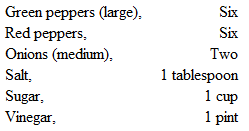
The young lady who gave this recipe to mother was a graduate of the college that leads in the teaching of domestic science and was herself a teacher at the time. Mother said it was a nice change to eat with cold meats, only Adelaide must be sure not to make the mistake she did when she (mother) first made it.
"What was that?" asked Adelaide.
"Well, dear, I forgot to remove the seeds from the peppers, and we nearly burned our mouths, it was so hot," mother smilingly replied.
Washing and wiping the peppers Adelaide cut them in halves and removed every seed.
She peeled the onions, then put the peppers and onions through the meat chopper.
Placing these in a saucepan, she covered them with boiling water and they stood for ten minutes before putting over the fire.
They boiled for three minutes and then Adelaide drained them in the wire strainer until they were very dry.
Returning to the saucepan, she added the tablespoon of salt, the cup of sugar and the pint of vinegar.
After boiling all the ingredients together for twenty minutes Adelaide filled the sterilized pint jars to overflowing, inserted a silver knife to let all air bubbles rise to the top and break, fitted on new rubbers smoothly, sealed the jars quickly and stood them upside down out of the way of any draft.
In the morning she looked the jars over carefully to be sure that they did not leak, wiped off the outsides with a damp cloth, pasted on the labels and stored the final results of her labor away in the preserve closet.
Mustard Pickles No. 1
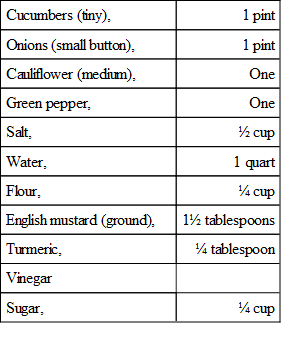
Each tiny cucumber was washed and wiped and placed in the saucepan. Adelaide covered the onions with boiling water for a few minutes, then let the cold water run into the pan while she peeled them—if you peel onions under running water you will not cry. These she added to the cucumbers.
The cauliflower Adelaide stood in a pan of cold water, to which she had added a handful of salt (this mother explained was to draw out any worms if there were any). Then she separated the cauliflower into small flowers, cutting off the thick stalk, and added to the cucumbers and onions.
The green pepper was washed and wiped, cut in halves and the seeds removed. It was then put through the meat chopper and added to the other vegetables.
Adelaide made a brine of one quart of water and one-half of a cup of salt. This she poured over the mixture of vegetables, covered and stood for twenty-four hours.
At the end of that time she placed the saucepan over the fire and let the contents heat through, then turned them into the colander to drain.
Mixing together the one-fourth cup of flour, the one and one-half tablespoons of ground English mustard, and the one-fourth tablespoon of turmeric powder with enough cold vinegar to make a smooth paste, Adelaide added one-fourth of a cup of sugar and sufficient vinegar to make one and one-fourth pints in all.
This mixture she boiled until it thickened and was smooth, stirring constantly with the wooden spoon, then added the vegetables and cooked until they were well heated throughout.
Filling the sterilized pint jars to overflowing, Adelaide inserted the silver knife to let all air bubbles rise to the top and break, fitted on the new rubbers smoothly, sealed the jars quickly and stood them upside down out of the way of any draft.
In the morning the jars were carefully inspected to be sure that they did not leak, the outsides were wiped off with a damp cloth, then Adelaide pasted on the labels and stored the pickles away in the preserve closet.
Mustard Pickles No. 2
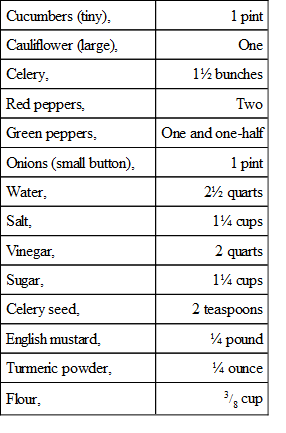
"You just wait, my dear, until Daddy finds out you have put up this special recipe of 'Mustard Pickles' and you'll have to hide them under lock and key, if you wish to keep any," said mother.




